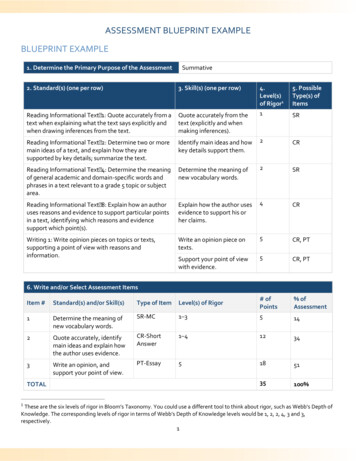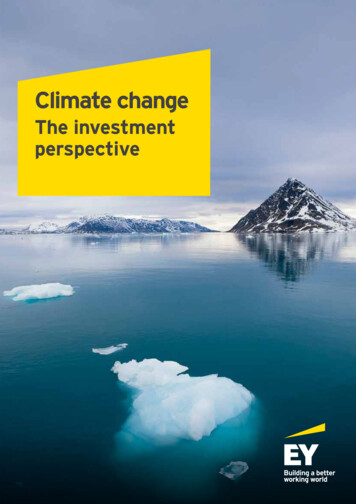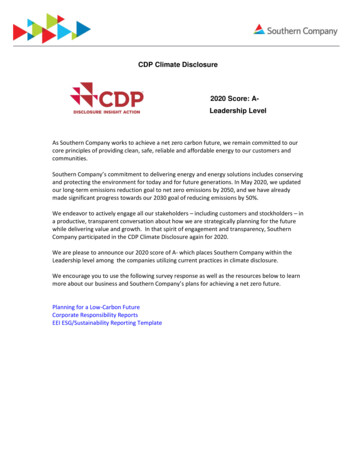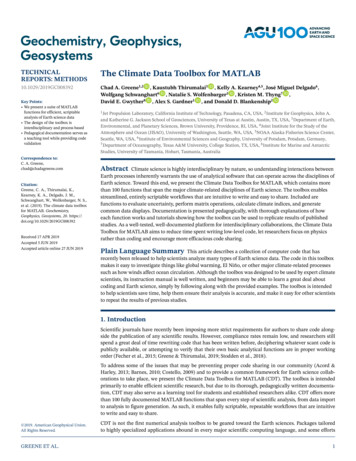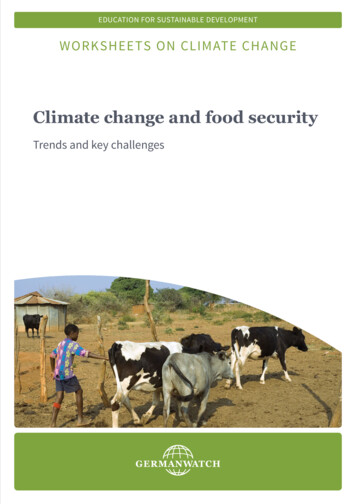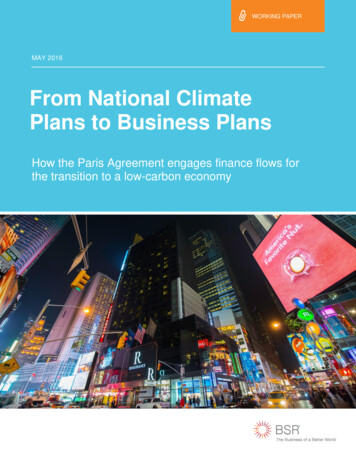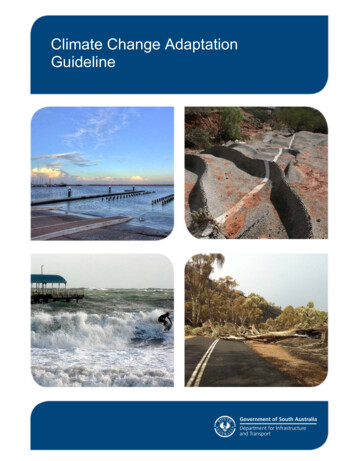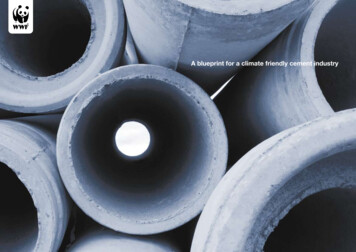
Transcription
A blueprint for a climate friendly cement industry
How to Turn Around the Trend of Cement RelatedEmissions in the Developing World.Photograph Jean-Philippe Mesguen Lafarge Photo LibraryA report prepared for the WWF –Lafarge Conservation PartnershipOn behalf of:WWF InternationalGlandSwitzerlandNicolas Müller & Jochen HarnischEcofys Germany GmbHNürnberg – Germany 49 911 994358-12
PrefaceThe crisis of climate change needs urgent solutions. This report proposes solutions for anindustry sector which is responsible for 8% of global CO2 emissions, the cement industry.As economies grow and get wealthier, the demand for construction materials such as cement and concrete is booming.This is particularly visible in emerging economies. The global cement industry is facing the challenge to sustain itsbusiness while decreasing its carbon intensity, from production processes, fuel uses and its product end use.Science tells us that the world must reduce its emissions of greenhouse gases by at least 80 per cent below 1990levels by 2050. WWF insists that developed countries show the way to this goal with decisive actions to reduce theiremissions by 25-40 per cent below 1990 levels by 2020 while supporting and financing additional emissions reductionsin carbon- and energy-intensive sectors in developing nations.This report offers a range of solutions to enable cement companies to turn around their growth of CO2 emissionsand shows how the cement industry can contribute to the task ahead of us. It describes a scenario in which theindustry sector grows to more than twice its size in volume by 2050 while it reduces its absolute CO2 emissions byapproximately three quarters compared to global emissions in 2007. Compared to a business‑as-usual scenario, thereduction options are even more impressive: the avoided CO2 emissions amount to 90% compared to the situation in a“frozen technology scenario” in 2050.WWF believes that cement companies around the world must take steps to reduce their carbon footprint today,both in emerging economies and industrialized countries. The solutions proposed in this report can help the industrymove in the right direction, set targets and take action that will lead to deep greenhouse gas emission reductions.It is clear that these actions need support from a corresponding policy framework, which must be based on strongcaps on overall emissions in developed countries. At the same time, the framework must ensure that developingcountries, in particular emerging economies, deviate substantially from a business-as-usual development path.A blueprint for a climate friendly cement industryii
PrefaceTo make this possible, sufficient financial resources and technology must be made available from developed countries.A policy framework specifically for the cement sector must contain the following elements: Policy regulations taking effect as soon as possible, which guarantee that any newly built or retrofitted cement plantsinstall only best available technology. A technology action programme to enable the industry to reach globally set sectoral standards. This actionprogramme should receive financial support for Non-Annex 1 countries from Annex 1 countries. Policies to support cross-sectoral mitigation efforts, as the end-user industries such as the construction industrywill play a crucial role in the efficient and appropriate use of cement. This type of cross-sectoral mitigation effort hasbeen largely unexplored to date. Policies that guarantee the sustainable production of biomass energy sources, which could reduce the industry’sdependency on fossil fuels. Standardized criteria and screens for financial service companies to define and integrate the climate risk of thecement sector and individual cement companies.While this report in particular focuses on solutions for the cement sector in China, it is obvious that these solutionscan and must be transferred to other countries as well, including industrialized countries. The carbon intensity ofcement production in industrialized regions, in particular in North America, is sometimes worse than that in emergingeconomies. WWF urges cement producers all around the world to develop serious action and investment plans toachieve a low carbon business model for their industry.WWF would like to thank the authors from Ecofys, as well as the experts and reviewers in China and elsewhere forthe excellent work contributed to this report. WWF would also like to thank Lafarge staff in France and China forcontributing their expertise and time to this report.Kim CarstensenLeader, Global Climate Initiative, WWF InternationalA blueprint for a climate friendly cement industryOliver RapfHead, Climate Business Engagement, WWF Internationaliii
AcknowledgementsWe would like to thank the following persons for their input made during and after the study trip to China:Sui Tongbo Vice President, Chinese Building Materials Academy.Kong Xiangzhong Secretary General, China Cement Association.Lui Ming Deputy Director, Office of Rare Earth & Building Materials of Department of Industry – National Development & Reform Commission.Tan Li Director of Foreign Affairs Office, Chinese Building Materials Academy.Cui Yuansheng Vice President, Institute of Technical Information for Building Materials Industry of China, National Cement Information Network.Zhuang Guiyang Senior Research Fellow, Research Center for Sustainable Development, Chinese Academy of Social Sciences.Chen Ying Senior Research Fellow, Research Center for Sustainable Development, Chinese Academy of Social Sciences.Zhang Ruiying Program Officer, China Sustainable Energy Program, Energy Foundation.Hu Xiulian Research Professor, Energy Research Insitute.Wang Lan China Building Material Academy.Cui Qi Director Professor, Research Institute of Cement & New Building Materials.Peng Zhihui Director, Chongqing Administration Office of Supporting Fees for Urban Construction.Mr. Farseer Department of Science and Technology of Ministry of Construction; Sino‑Dutch Sustainable Building Demonstration Project Management Office.He Hong Director Engineer; Chongqing Municipal Economic Commission.Jane Zhou Lafarge China, Senior Vice President.Frederic Vallat Resource Recovery Manager, Lafarge.Liu Zuoyi Senior Consultant, DigitalCement.Further we would like to thank all reviewers who contributed to this report through their comments: Lynn Price (LawrenceNational Berkeley Laboratories), Prof. Niklaus Kohler (University of Karlsruhe), Prof. Elmar Bollin (University of Applied SciencesOffenburg), Wang Lan (China Building Material Academy) and Ying Chen (Chinese Academy of Social Sciences).This report was prepared as a master thesis by Nicolas Müller at the University of Applied Sciences Offenburg (Germany)under the supervision of Prof. Elmar Bollin (University of Applied Sciences Offenburg) and Dr. Jochen Harnisch (EcofysGermany GmbH in Nürnberg (Germany)).A blueprint for a climate friendly cement industryiv
Contents1.Executive Summary . id expansion of production in developing countries .Cement related emissions and future climate action . .Conventional and advanced emission reduction options . .Improve the thermal efficiency of kilns .Increase the share of biomass .Improve the electrical efficiency of plants .Develop Carbon Capture and Storage (CCS) . .Use cement more efficiently .Expand the use of additives and substitutes to cement clinker .The result: a pathway to a low carbon cement industry .Making it happen – a climate-friendly cement industry .2.2.12.22.32.42.5Introduction . 10Background of this report . 10Scope of the study . 10Global emission and production scenarios . 11Cement in global mitigation scenario . 14Evolving climate policy framework . 143.Cement production and emission reduction options . .9.33.103.11Cement production . 17CO2 impact of cement production . 17Process energy efficiency . 18Kilns . 18Preheater and precalciner . 20Grinding and blending . . 20Transportation . 21Electricity efficiency. 22Electrical consumption . 22Waste heat recovery . 22Cement and power hybrid plants . 23Topping cycles . . 24Comparison of strategies . 24Fuel type . 25Conventional fossil fuels . 25Fossil based alternative fuels . 27Biomass . 29Clinker substitutes and alternative raw materials . 31Innovative cement based material . 33Transition to low CO2 products . 37More efficient use of concrete . 38Optimized construction. 38Durability of buildings. 39Disposal and recycling of concrete . 40Integrated analysis of potential . 40Carbon capture and storage . 41A blueprint for a climate friendly cement industry01010102020303030304054.Reduction scenarios for selected developing countries . 424.14.24.34.44.5Brazil .Malaysia .Morocco .Philippines .Discussion of commonalities and differences .5.Emission reduction scenarios for cement production in China . 85.95.10The framework .Production scenario for China .Demographics .National economy .Relation between wealth and cement demand .Scenario for China . .Energy sector in China .The Chinese cement sector: status quo and trends .Potentials and barriers for reduction measures . .
A blueprint for a climate friendly cement industry ii The crisis of climate change needs urgent solutions. This report proposes solutions for an industry sector which is responsible for 8% of global CO 2 emissions, the cement industry. As economies grow and get wealthier, the demand for construction materials such as cement and concrete is booming.
